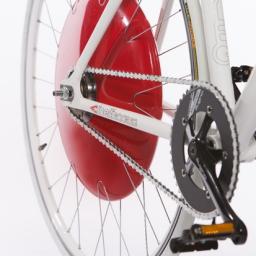
Interesting new tech if you're into bikes:
the Copenhagen Wheel is a disc-shaped module that can be retrofit onto almost any bike. It's:
... an electric pedal-assist motor fully contained in the oversized red hub of an otherwise normal back bicycle wheel. Inside that red hub is a delicately crammed array of computing equipment, sensors, and a three-phase brushless direct current electric motor that can feel the torque of my pedaling and add appropriately scaled assistance.
Replace the back wheel of any bike with the Copenhagen Wheel and it's instantly an electric bike-one that not only assists the rider but senses the surrounding topography and can even collect and share data about environmental, traffic, and road conditions. First developed in 2009, through a partnership between MIT's Senseable City Lab and the City of Copenhagen, the wheel is now in its first stages of commercial production. By the end of 2014, thousands will be shipped out to fulfill pre-orders around the world.
Sometimes you
do still have to pedal though.

Shortly after NASA awarded Boeing and SpaceX mult-billion dollar contracts in the "space taxi" program,
Sierra Nevada Corporation filed a lawsuit against NASA challenging its loss to Boeing, despite submitting a cheaper bid. While the lawsuit caused NASA to immediately request Boeing and SpaceX to halt work on their vehicles,
they've now reversed course and requested the programs be restarted. NASA stated that a delay in providing transportation services to the ISS crew will put the crew at risk and will highly affect several operations of the ISS. This delay may even result in the US failure to fulfill the commitments it made in its international agreements.
The lawsuit is starting to result in private internal documents coming out of the woodwork and into public view. While many speculated that NASA was fully behind SpaceX and only granted Boeing a chunk of the contract for political reasons, it seems that
Boeing was ranked above SpaceX in every major category, from technical maturity to management competence to likelihood of sticking to a timetable. Despite SpaceX's historic achievement of becoming the first commercial entity to put a capsule into orbit and ferry NASA cargo to and from the international space station, the agency had somewhat less assurance in the company's ability to perform, based on performance on its own preliminary contract.
When completed in 2022, the mammoth Thirty Meter Telescope will have eight times the light-gathering area of any other optical telescope.
But many Hawaiians are opposed to it.
The ceremony demonstrated the combustible mix of science, local traditions, and politics that have dogged the summit's development for decades and the TMT project in particular. The ceremony was interrupted for several hours as local opponents staged a peaceful protest[3], using their cars to block the road leading to the summit. Some held signs using TMT to spell out "Too Many Telescopes."
Mauna Kea, often translated as "White Mountain" because it's sometimes capped with snow, rises 13,796 feet (4,205 m) from the Pacific Ocean and is sacred to native Hawaiians. The dormant volcano is known locally as wao akua ("realm of the gods"), and its slopes are dotted with shrines, altars, and hidden burial grounds.
According to the master plan drawn up in 1983 (extended in 2000) between state environmental officials and the University of Hawaii, which manages the summit, no more than the 13 domes can be built on the summit. This limitation ultimately led to cancellation of plans to add four small "outrigger" telescopes to Keck Observatory's existing giant twin domes.
Despite the protests, construction for the TMT has been approved and will move forward. When completed, perhaps as early as 2022, the telescope will leapfrog to the top ranking of the world's largest optical telescopes.
Each of the 492 mirror segments that comprise the Thirty Meter Telescope's f/1 primary mirror will be constantly adjusted for optimum alignment. An 11-by-8-foot pickoff mirror protrudes through the central opening and directs light sideways to one of several planned instruments.
 Interesting new tech if you're into bikes: the Copenhagen Wheel is a disc-shaped module that can be retrofit onto almost any bike. It's:
Interesting new tech if you're into bikes: the Copenhagen Wheel is a disc-shaped module that can be retrofit onto almost any bike. It's: